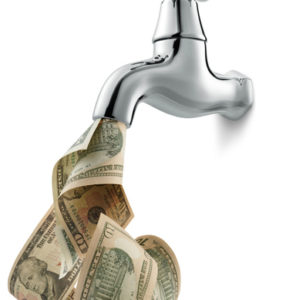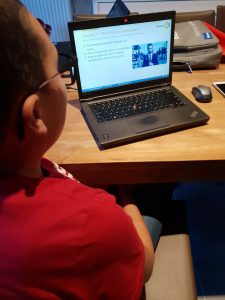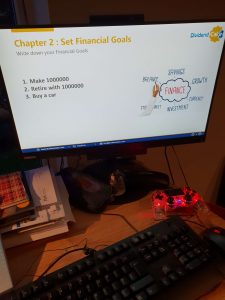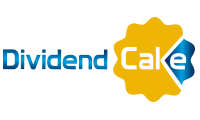Are you giving your kids or teenagers a financial literacy class or do you expect the schools to take care of that objective? The school educational system is failing….no doubt. Our teenage sons will get no financial literacy courses in the next 2 years.
That is one of the reasons why we started our blo g as we see too many people around us with poor financial literacy skills. We can’t afford that the school system fails our kids. We can’t let them enter the real life without knowing how to grow their money and just continue to put their money on a savings account. We have a responsibility as a parent.
g as we see too many people around us with poor financial literacy skills. We can’t afford that the school system fails our kids. We can’t let them enter the real life without knowing how to grow their money and just continue to put their money on a savings account. We have a responsibility as a parent.
In January 2018, we did set our Financial Education objectives for the year. You can read them all in our blogpost “2018 Financial and Travel Goals“. We have done two classes and you can find the blog posts below.
Financial Education Class 4 : Manage A Fixed Travel Budget
Financial Education Class 5 : Inflation – Are you losing money?
After the christmas exams of our sons, we planned another Financial Education Class. A quick class about the term “Cashflow”, what does it mean, how do you need to understand it, how do you use it ?
Financial Education Class 6 : Cashflow
First saturday after the exams was a perfect afternoon for another financial literacy class.

tap with money flowing against white background
After the difficult topic of class 5 inflation, I wanted to keep this financial class light. Just a few slides but let them do some work…
Here you find the explanation of each slide and what the key message is while giving this financial education class to your kids. You will also find this in the Notes Section of each slide. Read below the section of what my students think about this class.
Slide 1 : What did you learn last time ?
Last year in 2017, we did teach you 3 financial education classes. One class about budget, one about the compound interest and one class about the financial pyramid. Remember ?
You can tell me what you remember of those classes.
Slide 2 : What did you learn last time ?
The last class we did learn about the meaning of inflation and how it impacts your financial life. This topic “inflation” will impact your whole life. Why ? Because it has an impact on your savings, your expenses,…everything. So it is very important you understand what inflation means and how you should act going forward…got it?
Tell me again what it does mean….
To my joy both sons did remember the correct meaning of inflation.
Slide 3 : The definition of inflation
Read the definition of inflation. This is what we learned last time. It is when prices of goods and services are constantly going up. You don’t know about this as today you pay 1 euro but tomorrow you pay 1,15 euro. Small increases of prices over time.
Slide 4 : The impact on your Savings Account
But increasing prices has also an impact on your savings account. You lose purchasing power year over year. If you have 10.000 Euro, you can only buy goods for 8000 euro. Do you know how much interest you get on a savings account today ?
So you can buy less with this 10.000 euro.
Slide 5 : What is Cash Flow?
Today we will learn what cash flow means…this is about cash flow of money.
Slide 6 : What is Cash Flow?
A cash flow describes the movement of money. It is in its narrow sense the difference between income payments and outgoing expenses. In a project you can pay money for a future income.
Slide 7 : Cash Flow of a middle-class family
In this slide you see the income and expenses of a middle-class family. The salary of the husband and/or wife are consumed with paying the bills. Electricity bills, water bill, insurances,…are all expenses. The focus of a middle-class family is to pay the bills and pay off debt and only save what is left.
Slide 8 : How banks work with your money
 Let’s begin with explaining how banks operate with your money. You put the money you get from grandmother in a savings account. The bank will pay you minimum 0,11% on the money you park there. They take that money and give it someone else who want to take a loan to buy a house, a car, a vacation, start a company at 3%. A government also takes loans with central banks. The ratio from savings towards loans is around 1:10. They can give a % money to 10 people for every person putting money on the bank.
Let’s begin with explaining how banks operate with your money. You put the money you get from grandmother in a savings account. The bank will pay you minimum 0,11% on the money you park there. They take that money and give it someone else who want to take a loan to buy a house, a car, a vacation, start a company at 3%. A government also takes loans with central banks. The ratio from savings towards loans is around 1:10. They can give a % money to 10 people for every person putting money on the bank.
So I ask the kids…is the bank earning money ? They figure it out quickly. Banks make money on other people’s money…
Slide 9 : Do the following assets generate money ?
So does a car give you money ? Does a house give you money ? Does a bar of gold give you money ? Does a boat give you money ? The answer is NO. They all cost money and cars, boat prices depreciate normally very quickly.
The 4 assets only cost you money !

Slide 10 : Do the following assets generate cash flow ?
The first one is a savings account. Yes, this generates extra money…very little 0,11% today. The second one is renting a room in your house. If you find a person who wants to rent you room for several months, you generate extra cash flow from your room.
If you buy toilet paper to clean your butt, you might use toilet paper from the company Procter & Gamble. This company can make profit and you can become owner of a piece of this company when you buy 1 share of this company on the stock market. Then you are also owner of this company. This company can give you a part of this profit.
The last option is being an entrepreneur or generating extra cash from your car by being an UBER driver. You generate extra cash from driving your car. So these 4 assets generate extra cash for you !
Slide 11 : Dividend Cash Payout from Procter & Gamble
 As you can see on this slide, Procter & Gamble company has been paying out each year a dividend cash payout. Each year a little more. So if you purchased 1000 shares of this company, you would have received 2660 $ per year in 2016. You can pay a nice vacation for that money.
As you can see on this slide, Procter & Gamble company has been paying out each year a dividend cash payout. Each year a little more. So if you purchased 1000 shares of this company, you would have received 2660 $ per year in 2016. You can pay a nice vacation for that money.
Slide 12 : Cash Flow Quadrant
There are 4 types of cash flow people. You can be an employee or self-employed such as a doctor or a dentist. So here you have a job in a company or at the government or you own a job. You get paid for your time. 95% of the people do this until they die.
More important is the other side of the quadrant. You can be a business owner. A person with multiple restaurants such as Pizza Hut has a system of selling pizzas where other people work for him. He has a system. You can also be an investor and then money works for you. If you buy shares of the company Procter & Gamble you are an investor. You receive passive income in the form of dividends. Your income is not dependent on you being present all the time.
Slide 12 : Let’s Work !
So in the last class you received a book. Read the first two chapters and write down in a powerpoint template your key learnings !
The two boys sit down and start to read. Read in the next session what they did learn.
Feedback and Key Learnings from my students
So after reading the two chapters, each son walked me through their two slides. The first boy A. gave the following three reasons why he should grow 100$ towards 1 million dollar :
- Being able to buy the things you want
- For emergencies that aren’t cheap
- For not being dependent on a job that I don’t like
My other son I. gave the following three reasons :
- For retiring early
- For my retirement
- For my kids so that have a good life in the future.
Wow ! Impressive answers and mindset of the two 14 year old boys ! I hope they will keep it like this… The second question was to define your financial goals for the future. The first son A. gave the following three objectives :

- To purchase a house
- To have 5 dogs
- To have the car of his dreams
I explained him that all those “things” or animals are assets that cost money….So he will have to grow his money to buy and/or maintain all those assets. My second son had a complete different answer :
- Make ONE MILLION
- Retire with ONE MILLION
- Buy a car
He explained that his first goal was to get to 1 million as soon as possible. The car and the house was not so important. Well interesting perspectives of the two boys. Did you have a conversation with your kids already about their financial goals ? Probably not… you will wait until they are 18 or older and let them figure it out by themselves, right ?
I was definitely pleased that they did think about it. Now we can slowly take the next steps.
Our presentations
Download here our training material
English version :
DividendCake_Kids Financial education 2018 Class 3 Cash flow
Dutch version :
I will add during the week.
Final Words
So the financial education class 6 has been posted. Now it’s up to you as a parent to teach your kids…you have a responsibility. What was the present we gave our kids as an incentive for attending this class. We gave them 10 Euro. Let’s see what they do with this money.. The goal for this year is to have 5 financial education classes. They had 3 so far. Let’s plan two more before the year ends. It’s christmas vacation time and we can use our time useful.
So this was the end of our class and we hope you enjoyed reading this blog post…do you want your kids to learn financial literacy ? Stop your excuses, educate yourself and teach your kids so they are prepared for the real life.
With our blog, we can have an impact in educating financial literacy and helping parents ! You can download all our training materials for free. We hope you appreciate our effort and many hours putting this together.
Leave a comment if you like what we are doing. Thanks for following us on Twitter and Facebook and reading this blog post.
As usual we end with a final quote.


No Comment
You can post first response comment.